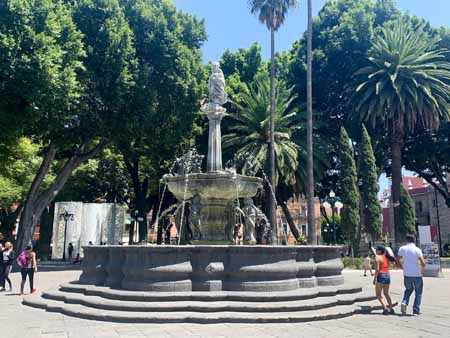
Oh, Puebla. How I wish I had a few more days to really get to know you.
We barely dipped our toe into the pool of Puebla, but I’m glad we did (there’s no pool or ocean here in Puebla – just to be clear – we are in the middle of Mexico).
It’s been like a quick sampler, and we’ve liked what we’ve seen. We liked it a lot.
We had 3 nights, 2.5 days to explore and we packed in as much as we could.
Starting From Scratch
Turns out Puebla is the only major Mexican city that the Spanish didn’t build on top of an existing pre-Columbian settlement. Puebla could be called Mexico’s only true Colonial city.
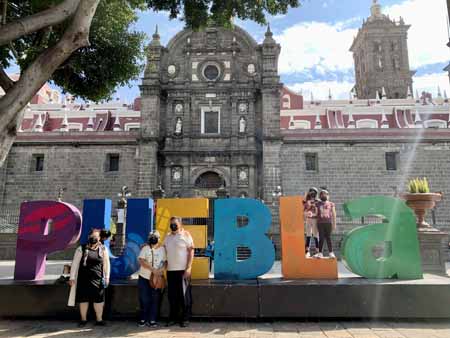

When the Spanish established the city of Puebla in 1531, it became a stopping point between Mexico’s most important cities at the time, the port city of Veracruz and the central city of Mexico City.
Colonial Architecture for the Win
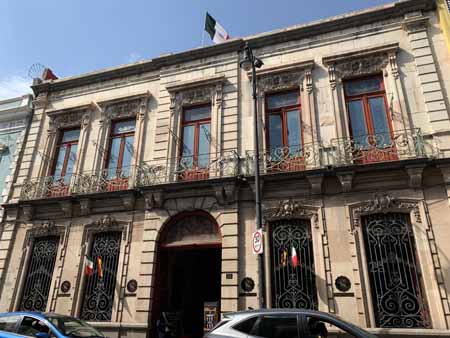
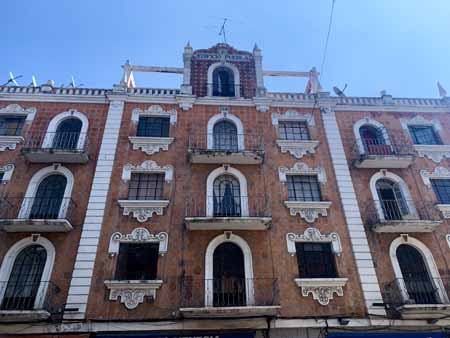

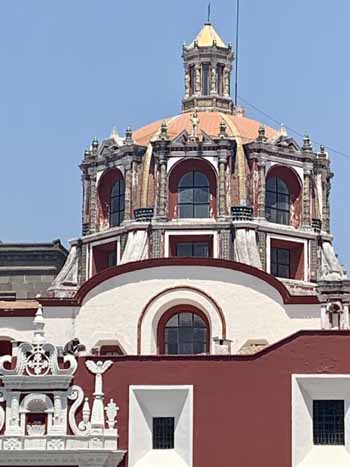
Puebla has an abundance of colonial architecture. Ornate wrought iron balcony railings call to me on practically every street.
Symmetry abounds in the mostly two-story structures. There are plenty of domes and Moorish influence to be seen, along with soft arches, carved wooden doors, dark wooden beams, stucco walls, and, of course, bright interior courtyards full of lush green plants.
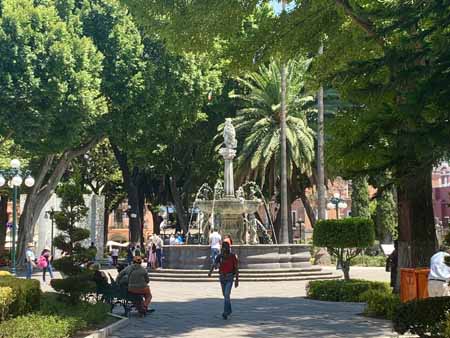
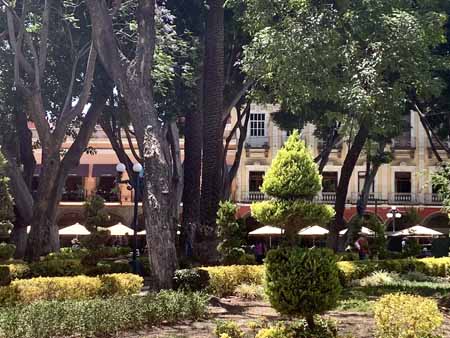
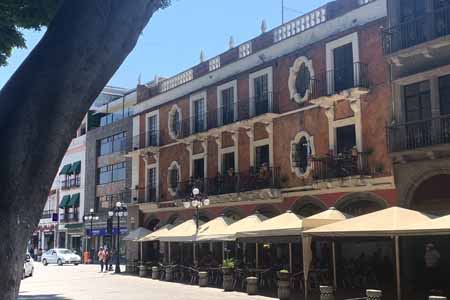
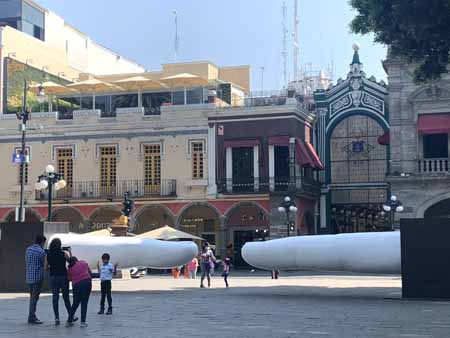
The Zocalo de Puebla (main plaza) is as lovely as can be with tall trees and gorgeous landscaping, all surrounding a huge trickling fountain. There’s also two huge, stark white fingers reaching out about to touch. It’s quite the photo op.
Puebla was a land of riches and the city reflected the wealth.
The Spanish used an orderly grid system for the city’s layout. It’s flat and predictable.
The Walking Tour
It’s easy to walk here, so it made sense to book a walking tour on our first full day. A local medical student, Omar, was our tour guide and he took us to see the highlights of the town for a few hours.

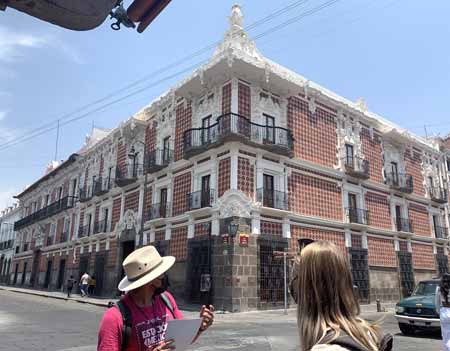
He started off by giving us a very condensed Mexican history lesson starting with the Olmec people in 1600 BC, on up to the present day. He did this in about 10 minutes, so it definitely was the Cliff Notes version of Mexico’s evolution.
Cathedral of Our Lady of the Immaculate Conception
After our condensed history lesson, we walked to the Cathedral of Our Lady of the Immaculate Conception, or the Basilica Cathedral de Puebla, as it is known. Construction of the Cathedral began in 1575. The Cathedral has a floor to ceiling organ, and the ceilings are 230 feet high. Now that’s a real Cathedral ceiling.
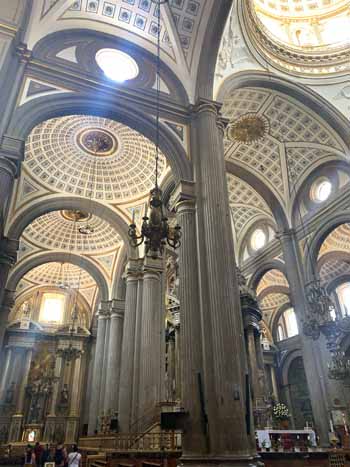
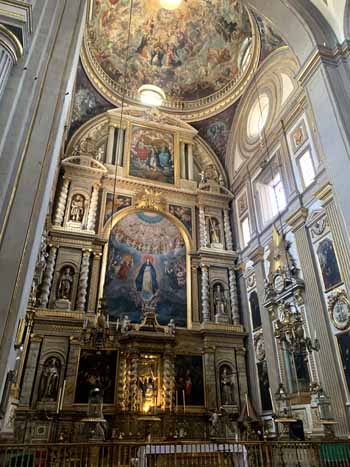
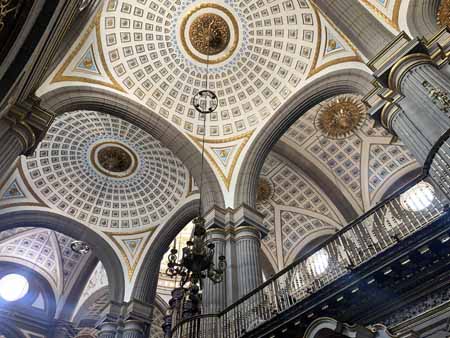
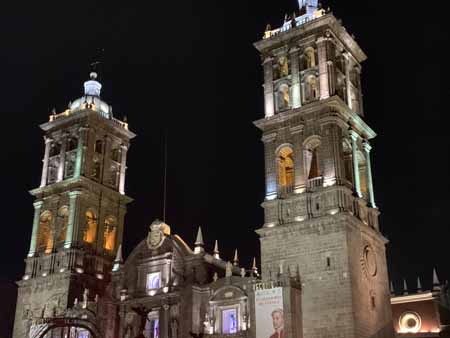
But what really impressed about the Cathedral were the white domes with small areas of light blue with gold accents, repeated over and over throughout the ceiling of the cathedral.
That View
It so happens we have an unobstructed view of the Cathedral from our hotel’s rooftop patio, so we can drool and stare all we want for free, vs. the high priced rooftop restaurant and bar right next door. Gotta love that.
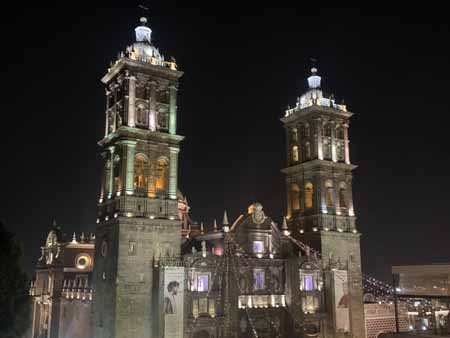
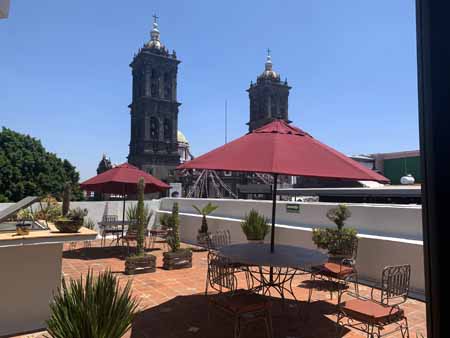
Treats & More Treats
There’s two blocks in town dedicated to traditional Mexican candy and treat stores. That’s where Omar ended our almost 3 hour tour. It’s never a bad choice to end with treats, I think we’d all agree.

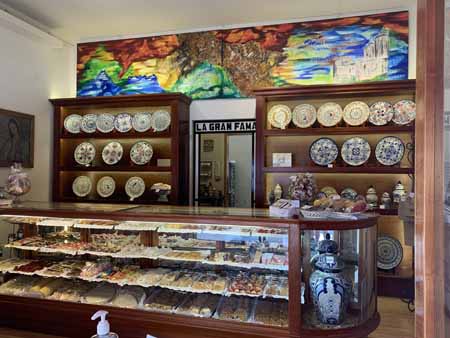
Omar was able to score us each a sample of a Santa Clara cookie, a delicious cookie made with a pumpkin seed frosting. Yum.
And yes, somehow we made it back to that same street the next day on our own. And we found those same pumpkin seed iced cookies too. Imagine that!
The Revolution of 1910

The first shots of the Mexican Revolution of 1910 were fired at the Serdan home right on “treat” street. We could see the bullet holes splattered across the outer walls. It was jaw-dropping to see the large bullet holes all over the stucco exterior and imagine the Mexican army being ordered to attack the private home full of family members.
Museo Regional De La Revolución Mexicana Casa De Los Hermanos Serdán
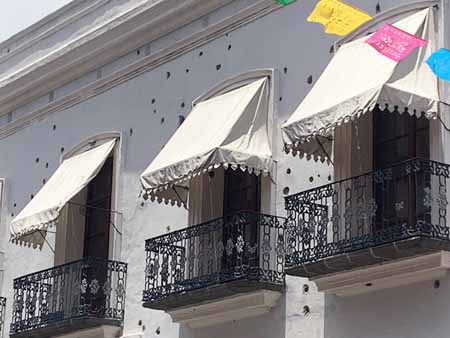
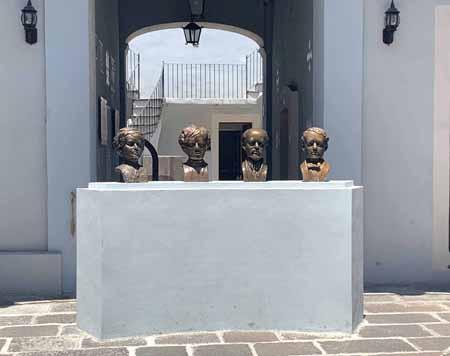
We visited the Serdan home, which is preserved as a museum, the next day. Unlike many museums, with the exception of Mexico City, it had long explanations of the history and the critical role of the people who lived there in English (yeah!).
Typically you’ll find us at a museum with our translator app set to camera mode, taking a picture of the posted information for each exhibit. It’s like putting a sign across our bodies, “WE ARE TOURISTS, WE DO NOT SPEAK YOUR LANGUAGE”, but that’s ok, because we are tourists.
The Aquiles Serdan Family
The Serdans were a wealthy and influential Mexican family in Puebla. They were liberal thinkers and vehemently opposed to the huge disparity between the few wealthy upper class Mexicans and everyone else. And I mean everyone else- farmers, engineers, teachers, laborers, cooks, cleaners, etc. There was no possibility of upward mobility. If you were born poor, you likely died even poorer.
Let’s Organize
The Serdans wanted change and started gathering weaponry and organizing secret meetings in their home for over a year before the first battle in November of 1910, which took place both outside and inside their residence.
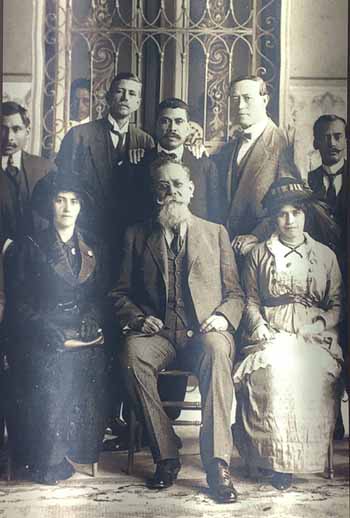

They were a heroic and brave family. They all bore guns and fought valiantly to bring democracy and freedom to their countrymen.
A Sad Ending, But a New Beginning
Aquiles Serdan was one of Mexico’s most prominent revolutionary martyrs. He and his two brothers were killed in the battle that day on November 10, 1910 in their home.
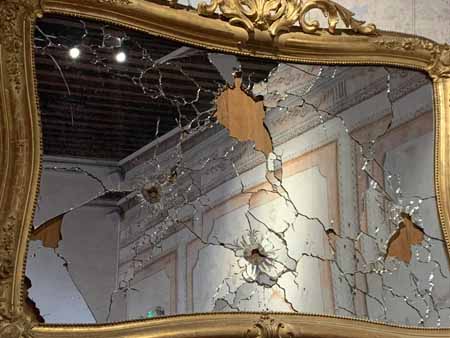
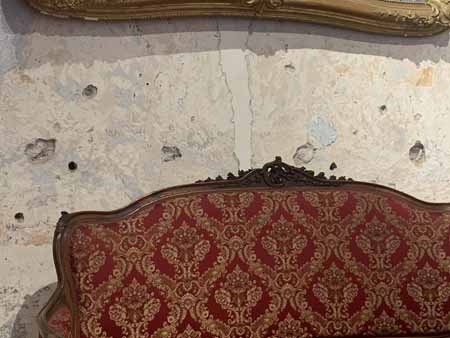
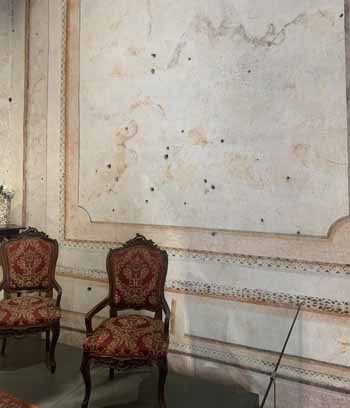
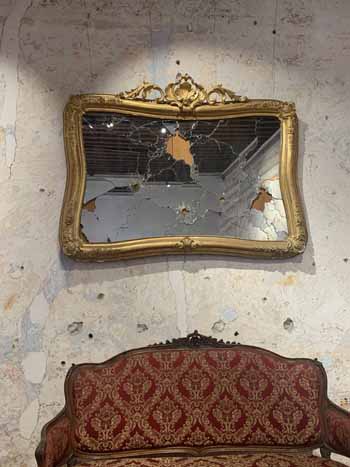
His two sisters were jailed, and later taken to spend the rest of their days in a hospital setting that their lawyer was able to secure for them due to their “delicate condition”. And no, I’m not exactly sure what “delicate condition “ they were in, but I’m thinking the hospital setting was way better than the Mexican jail (hopefully).
It was a sad end to the Serdan family, but the start of a new beginning for Mexico.
The Serdan Family Kitchen
The large and beautiful (minus the bullet holes) Serdan home had the kitchen of my Mexican dreams. Anyone who’s been to my home knows I have Mexican Talavera tiles in my kitchen backsplash. I just love the artistry, the colors, and the uniqueness of each hand made tile.
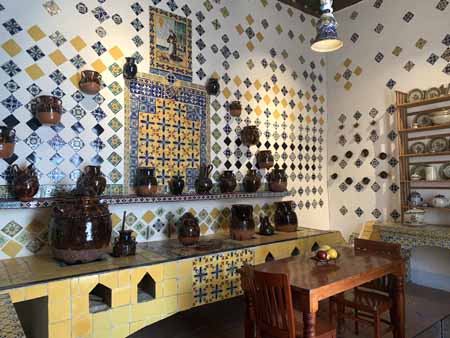
So, in I walk to the Serdan’s 100 year old kitchen, and I swoon. Well, not really, but I swooned on the inside.
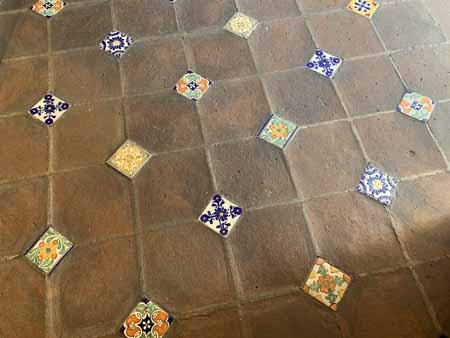
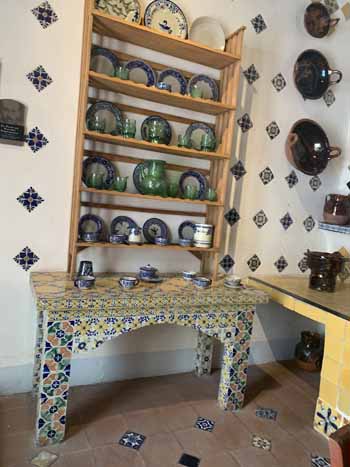
Talavera tile everywhere, in many patterns with colors on every surface imaginable. Oh, and even the floor took my breath away with the ruddy red tiles with Talavera accents. I love it.
Talavera Pottery
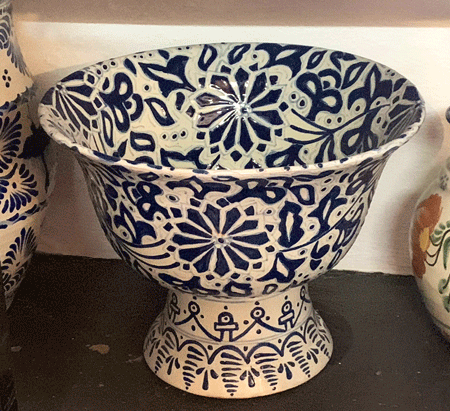
Too big to carry home. Too expensive to ship.
But I’ll always have the picture.
Who knew that Puebla is home to traditional Talavera making? Well, actually, I did. I will admit.
Could that be a part of why we just had to get to Puebla, even for just a few days? Perhaps it was one of the reasons.
Popocatépetl, or El Popo
I’d also been reading so much about the beauty of Puebla, the outstanding food of Puebla (birthplace of Mole), and, of course Popocatépetl, or “El Popo”, the local volcano that rises high to a peak covered in snow in the not so far off distance.
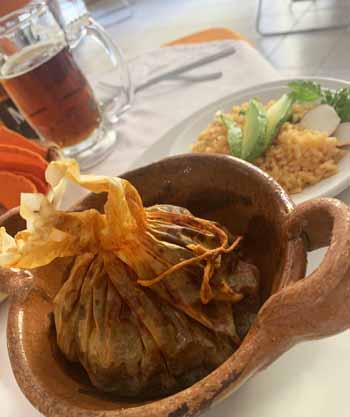
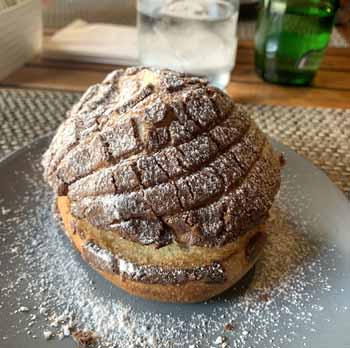
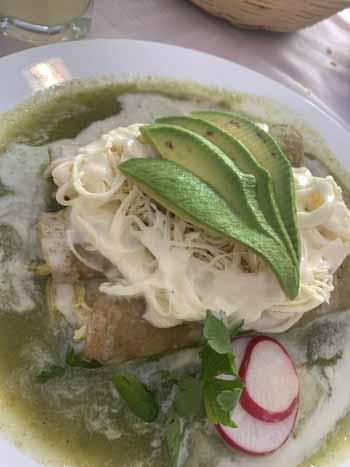
I had read that El Popo is the second highest volcano in North America. But what I hadn’t read, until after we arrived in Puebla, is that El Popo is Mexico’s most active volcano and it’s a good idea to check on the activity level before going to the region. Oops. Fingers crossed.
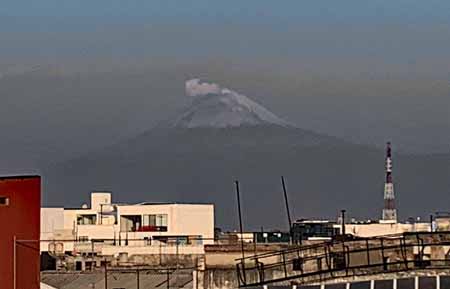
We did get a pretty good view of the volcano our second morning. Then a bit later in the day I checked again and El Popo had what may have been, in my completely uninformed view, a somewhat significant amount of steam-smoke-ash coming out the top. Pretty cool. Or hot, should I say.
Kindred Spirits
One of the best benefits of the walking tour was meeting our parallel-life friends, Jens and Kelly from Flagstaff, Arizona. We became fast friends and found that we had so much in common, it was almost eerie.
And besides all our uncanny similarities of our past lives and family circumstances, we also share a love for long term travel. We’d both spent many months in SE Asia before Covid hit, and obviously love traveling in Mexico too.
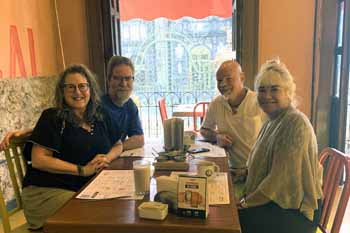
Jens & Kelly breakfast with Tracy & Steve
Unfortunately we’ll be heading back to Seattle in a week, while Jens and Kelly have an open itinerary. I’m envious, but it will also be nice to get home to friends & family, a familiar bed, and Bailey, our Lab.
Last Night in Puebla

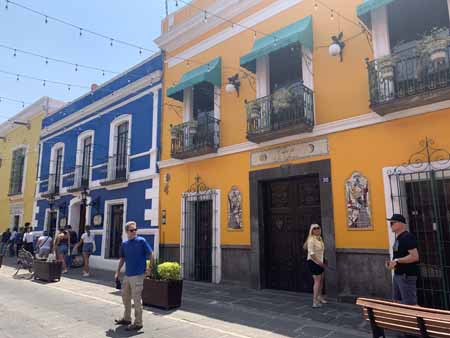
Just like the previous night, we walked to a restaurant we’d carefully selected, and found it closed. So we walked to a second carefully selected restaurant and it was also closed. Please note, both said “open” in Google maps. Note to self: You can’t rely on Google maps for restaurant hours.
So, in a somewhat desperate move, we went to a three dollar sign ($$$) restaurant, El Mural Poblanos, that we had just passed by. Our first 3 dollar rated restaurant of the trip.
Did I mention it had started raining? That may have factored in our decision to indulge in the 3 dollar sign feast.
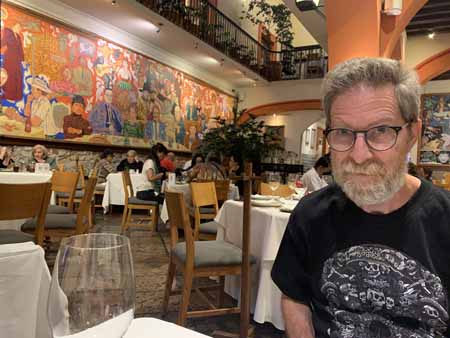
The restaurant is well known for having superb food, especially Mole, and beautiful, colorful murals cover the walls.
We were seated and waiting for our food. Suddenly there was a gigantic crash about 10 feet behind me. The waiter had dropped an entire platter of food he was bringing out of the kitchen to serve. It was chaos there for a moment as the entire restaurant seemed to stop and turn to see what had happened.
Dishes were shattered, large chunks of beautiful pottery lay on the floor amidst what looked like enchilada mole (my order).
We’re not sure if that actually was our order, but the food sure was taking a long time to get to our table after that unfortunate event. I guess we’ll never know, but eventually our food did arrive and it was worth the wait.
WINS
A Helping Hand
The Departures desk worker at the bus terminal made a point of coming over to us to see if we were in the right place. We noticed he didn’t do that for anyone else in the crowded Puerto #3 terminal. So nice that they look out for the Gringo tourists. We appreciate it! And we were in the right place, by the way.
More Mole, Por Favor
I tried the sampler Mole enchilada plate and the Adobo Mole won hands down. What great flavor!
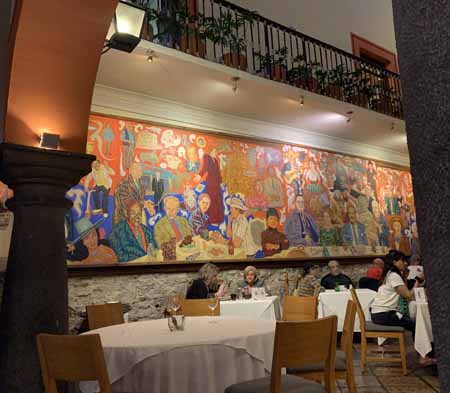

Habla Espanol?
Before leaving for Mexico I used a free “learn Spanish” app, Duolingo. There’s a type of lesson where the learner (that’s me) has to speak into the phone’s microphone and correctly pronounce the words in Spanish.
Well, quite often I would get stuck on the pronunciation lesson….and I’d keep getting the DO NOT PASS GO signal. I literally wouldn’t be able to move on to the next lesson because apparently I couldn’t even correctly pronounce the most simple words, like “adios”. It was super frustrating.
Well, I’m happy to report that I tried the app again a couple of days ago and PRESTO, I passed every pronunciation lesson with flying colors. I owe it to being immersed here in Mexico for a month, hearing Spanish constantly, and trying to speak it gingerly and cautiously. Makes me so happy. Adios Amigos!
LOSSES
Just like Seattle
Had our first real rain both evenings here in Puebla, but it was brief and just reminded us of home, so not really a loss.
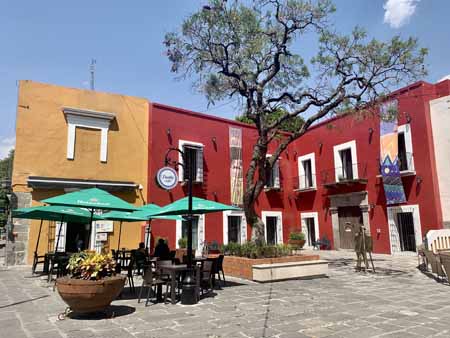

There’s Something About Steve
We were seated in the crowded Estrella Roja (bus company name) waiting area in the Mexico City bus terminal heading to Puebla. Almost all the seats were full of people waiting to board their bus.
A cleaning woman came by mopping along the main aisle. She suddenly turned towards Steve and without skipping a beat she motioned for him to lift his feet. She then proceeded to mop thoroughly under his feet and chair as he strained to hold his legs up high until she was done. It was so odd. I was stunned and trying not to start laughing out loud.
She finished cleaning Steve’s area and continued on down the aisle. No one else was asked to lift their legs or move, including me. I guess there’s something about Steve she knew that we didn’t. 🙂


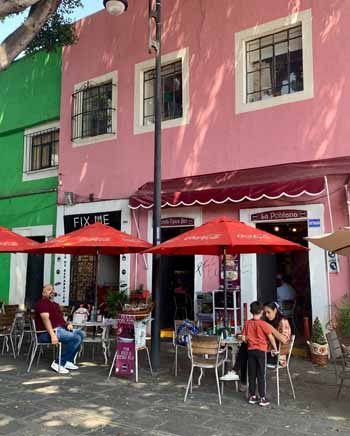


We loved Puebla and hope to return again!